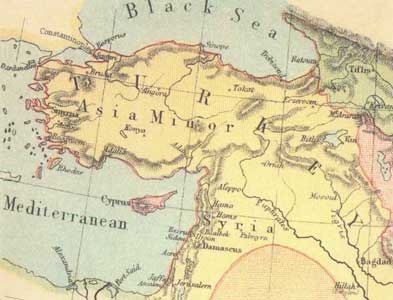| UCLA Library Special Collections |
 |
|
A
craze for all things Turkish swept Europe in the 1700s,
probably as a result of the first European translation of
the Arabian Nights (into French, by Antoine Galland
in 1704-17, and then into English in 1706). Europeans were
enthralled by the tales of sultans, slaves and harems; suddenly
turbans, satin slippers, harem pants, Turkish-style gowns
and Turkish carpets were the rage. Lady Mary Wortley Montagu’s
Letters went into 23 editions between 1763 and
1800. The fad affected music, too. Mozart wrote two “Turkish”
operas – The Abduction from the Seraglio
(premiered in Vienna in 1782) and Zaide.
|

 |
|
|
 |
|
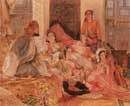 |
| 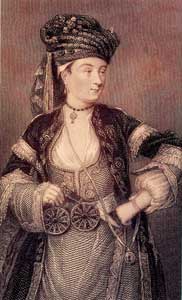
|
Lady
Mary Wortley Montagu
(1689-1762)

When her husband was
appointed Ambassador to Turkey in 1716, Lady Mary decided
to travel with him, a scandalous decision for a woman at
the time. She was the first to write about the mysteries
of the seraglio, declaring that
|
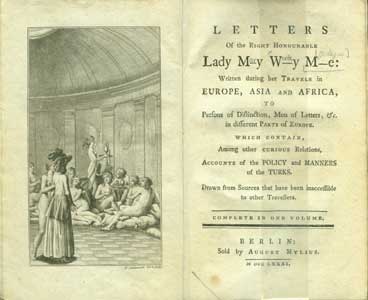
Lady Mary Wortley
Montagu. Letters … Written during her Travels
in Europe, Asia, and Africa to Persons of Distinction, Men
of Letters, &c. … which Contain … Accounts
of the Policy & Manners of the Turks. Berlin: Sold
by August Mylius, 1781. |
| Turkish
women had more freedom than English women. She was also broad-minded
enough to have her own children “engrafted” with
the smallpox virus, a practice she learned from Turkish medicine
women, and took this knowledge back to England with her -
seventy years before Jenner’s vaccination. |
Emmeline
Lott. The English Governess in Egypt: Harem Life in
Egypt and Constantinople. London: Richard Bentley,
1866.
Miss Emmeline Lott
accepted a two-year appointment, in 1863, as governess to
the five-year old son of Ismael Pacha, the Viceroy of Egypt,
in 1863. She lived in the harem, where she was responsible
for the education (and life) of her young charge. She endured
“fever, cholera and poor diet,” and found the
whole experience “lewd” and offensive. Her books
were bestsellers.
|
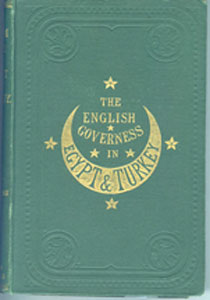 |
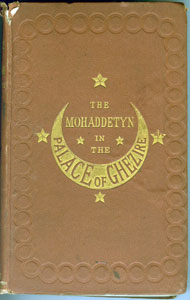 |
Emmeline
Lott. Nights in the Harem. London: Chapman and
Hall, 1867.
A book of tales à
la Arabian Nights, written, says Lott “to show
how his Highness the Grand Pacha and his Highnesses …
are accustomed to pass their evenings in the Viceregal Odalisk.”
|
| 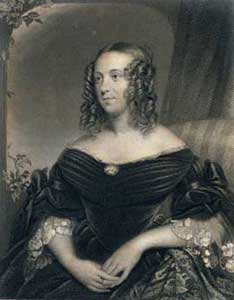
|
Julia Pardoe
(1806-1862)
Miss Pardoe was a prolific poet,
novelist and travel writer. This attractive book about her
trip to Constantinople with her father, in 1835, achieved
considerable success. |
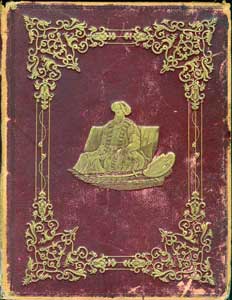
Julia Pardoe. The
Beauties of the Bosphorus. London: Published for the
proprietors by G. Virtue, 1838. |
THE
HAREM
For Westerners, the
harem was a symbol of passion and forbidden sensuality.
Fascination with Eastern exoticism intensified in the nineteenth
century as painters like Delacroix and Ingres covered their
canvases with voluptuous odalisques. Women travelers had
an advantage here, as only they had access to the opulent
Turkish baths and seraglios. By the 1840s, every serious
female travel writer visited a harem and wrote about it.
Opinions varied; not everyone agreed with Wortley Montagu
about the sexual freedom of Turkish women. Harriet Martineau,
for example, described them as “the most injured human
beings I have ever seen … if we are to look for a
hell upon earth, it is where polygamy exists.”
|
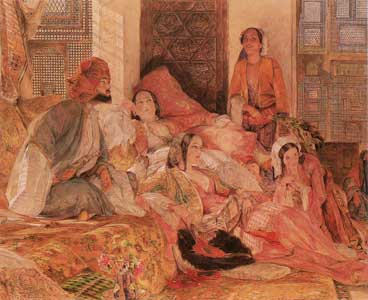
The Harem by
John Frederick Lewis (Victoria and Albert Museum) |

wilder
shores exhibit home |
europe
| russia
| turkey
| the
middle east | india
and the far east | africa
| the
americas | credits
©
2007 by the Regents of the University of California. All rights
reserved. |
|
Wilder
Shores is organized geographically, loosely following the structure
of Barbara Hodgson’s book No Place for a Lady: Tales of Adventurous
Women Travelers. (Berkeley: Ten Speed Press, 2002). The exhibit features
books and manuscripts, both by and about, women who traveled to these
regions:
|
